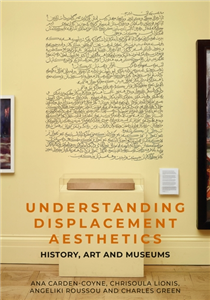Understanding displacement aesthetics
History, art and museums
by Ana Carden-Coyne, Charles Green, Chrisoula Lionis, Angeliki Roussou
Description
More Information
Rights Information
Albania, Algeria, Angola, Argentina, Armenia, Australia, Austria, Bahrain, Belgium, Belize, Benin, Bolivia, Bosnia and Herzegovina, Botswana, Brazil, Bulgaria, Burkina Faso, Burundi, Cameroon, Canada, Cape Verde, Central African Republic, Chad, Chile, China, Colombia, Comoros, Congo [DRC], Congo, Republic of the, Costa Rica, Ivory Coast, Croatia, Czech Republic, Denmark, Djibouti, Ecuador, Egypt, El Salvador, Equatorial Guinea, Eritrea, Estonia, Ethiopia, Faroe Islands, Finland, France, French Guiana, Gabon, Gambia, Georgia, Germany, Ghana, Greece, Guatemala, Guinea, Guinea-Bissau, Guyana, Honduras, Hongkong, Hungary, Iceland, India, Indonesia, Iran, Iraq, Ireland, Israel, Italy, Japan, Jordan, Kazakhstan, Kenya, Kuwait, Latvia, Lebanon, Lesotho, Liberia, Libya, Lithuania, Luxembourg, Macau, China, Macedonia [FYROM], Madagascar, Malawi, Malaysia, Mali, Malta, Mauritania, Mauritius, Mayotte, Mexico, Mongolia, Montenegro, Morocco, Mozambique, Namibia, Netherlands, New Zealand, Nicaragua, Niger, Nigeria, Norway, Oman, Pakistan, Panama, Paraguay, Peru, Philippines, Poland, Portugal, Puerto Rico, Qatar, Reunion, Romania, Russia, Rwanda, Saint Helena, Sao Tome and Principe, Saudi Arabia, Senegal, Serbia, Seychelles, Sierra Leone, Singapore, Slovakia, Slovenia, Somalia, South Africa, South Korea, Spain, Sri Lanka, Sudan, Suriname, Swaziland, Sweden, Switzerland, Syria, Taiwan, Tanzania, Thailand, Timor-Leste, Togo, Tokelau, Tunisia, Turkey, Uganda, Ukraine, United Arab Emirates, United Kingdom, United States, Uruguay, Venezuela, Vietnam, Western Sahara, Yemen, Zambia, Zimbabwe, South Sudan, Cyprus, Palestine, Bangladesh, Cambodia, Liechtenstein, Azerbaijan, Jamaica, Kyrgyzstan, Dominican Republic, Myanmar, Monaco
Reviews
With the rise of humanitarianism and international refugee laws in the 20th century, visual representations of refugees and their forced displacement permeated the cultural sphere. Understanding displacement aesthetics offers a groundbreaking analysis of the role of visual culture, art and art museums in shaping ideas about people forced to flee. The book identifies the refugee as a cultural figure, analysing the longer history of visual motifs and tropes and their ongoing presence in the contemporary world. Highlighting displaced artists in contemporary contexts, the book explores the barriers they face and their aesthetic outcomes. Language, identity and labour are identified as critical factors informing how art is made, curated, collected and understood by the public. Advancing the new concept of 'displacement aesthetics' - the negotiation of representation, lived experience and institutions - the interdisciplinary research underpinning this book provides a major intervention into the fields of cultural history, art history, and museum studies. Combining archival research, analysis of art, and curatorial research with artists and museums, Understanding displacement aesthetics presents new insights into the role of art and culture in mediating this pressing social and political issue in the 20th and 21st centuries.
Author Biography
Professor Ana Carden-Coyne is Director of the Centre for the Cultural History of War at the University of Manchester Charles Green is Professor of Contemporary Art in the School of Culture and Communication at the University of Melbourne
Manchester University Press
Manchester University Press is a leading UK publisher known for excellent research in the humanities and social sciences.
View all titlesBibliographic Information
- Publisher Manchester University Press
- Publication Date January 2026
- Orginal LanguageEnglish
- ISBN/Identifier 9781526181480 / 1526181487
- Publication Country or regionUnited Kingdom
- FormatPrint PDF
- Pages280
- ReadershipGeneral/trade; College/higher education; Professional and scholarly
- Publish StatusPublished
- Dimensions240 X 170 mm
- Biblio NotesDerived from Proprietary 6273
- Reference Code16677





